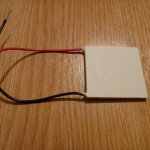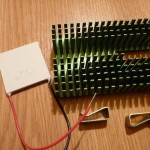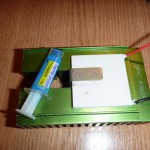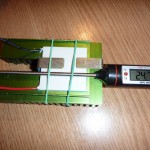“The thermoelectric effect is the direct conversion of temperature differences to electric voltage and vice versa. A thermoelectric device creates a voltage when there is a different temperature on each side. Conversely when a voltage is applied to it, it creates a temperature difference (known as the Peltier effect). At atomic scale (specifically, charge carriers), an applied temperature gradient causes charged carriers in the material, whether they are electrons or electron holes, to diffuse from the hot side to the cold side, similar to a classical gas that expands when heated; hence, the thermally induced current.
This effect can be used to generate electricity, to measure temperature, to cool objects, or to heat them or cook them. Because the direction of heating and cooling is determined by the sign of the applied voltage, thermoelectric devices make very convenient temperature controllers.” Source.
I recently got a 150W peltier element on Ebay:

The parameters are:
– Operating voltage: 0 – 15V DC
– Current: 0 – 10 Amps
– Temperature interval: -60°C to 180°C
This device works like a heat pump: it has two sides, the cold and the hot. Between these sides there are several thermo couples. All those thermo couples are interconnected and to the two wires that comes out. If voltage is applied, the heat is transferred from the cold side to the hot one.
The device does not “generate” heat nor cold, it just transfers heat. It is also called a thermo-electric cooler or TEC for short.
Because of the internal proximity, a part of the pumped heat can radiate back to the cold side. So the temperature difference is limited. Sometimes it can reach a temperature difference of 80 degrees Celsius.
As indicated in the datasheet, when applying DC 12V, one side becomes cold and one very hot, but the heat radiates and in a few moments the side that should be cold receives heat as well.
To maintain the cold side, the heat must be evacuated from the TEC hot side.
Theoretically with an ideal heat-evacuation system, I should be able to bring the cold side down to -60°C (room temperature ~ 22°C – 80°C ~= -60°C).
So for a start, I’ve added a heatsink:
 |
 |
 |
I’ve also used Thermal Grease for a better thermal contact of the TEC and the heatsink.
To improve the results even further, the heatsink has been merged in a volume of cold water. By doing so , the lowest temperature I got was -3.0°C, and I was able to instantly freeze a few drops of water placed directly on the cold side of the TEC. See this video, I’ve added a thermometer to observe the temperature evolution:

Dear Radu,
3years before I had a pelier set. I lost it. It is intresting thing.
We cant buy in my country.
Thanks
Where are you from?